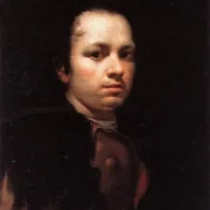 1746 - 1828
rococo, romanticism
1746 - 1828
rococo, romanticism
Description Francisco De Goya y Lucientes
Francisco de Goya y Lucientes, born March 30, 1746, in Fuendetodos, Spain, emerged as a groundbreaking figure in the art world, transcending traditional boundaries and leaving an indelible mark on the evolution of Spanish painting. His life unfolded against the backdrop of political turbulence, and his art became a mirror reflecting the complexities of the human condition.
Goya's early artistic journey led him to study under José Luzán, followed by a stint in Italy to absorb the grandeur of classical art. Upon returning to Spain, he found favor with the royal court and embarked on a journey that would see him evolve from a court painter to a revolutionary artist challenging societal norms.
The turning point in Goya's career occurred in 1792 when he fell seriously ill, a brush with death that left a profound impact on his art. His works took on a darker, introspective tone, epitomized by the haunting "Black Paintings" that adorned the walls of his Quinta del Sordo residence. These paintings, including "Saturn Devouring His Son," delve into the macabre and the psychological, revealing Goya's unflinching gaze into the human psyche.
Goya's social consciousness manifested in his series "Los Caprichos," satirical etchings critiquing the follies of Spanish society. The biting commentary and grotesque imagery showcased his willingness to challenge authority and question societal norms.
The Peninsular War and subsequent French occupation profoundly affected Goya. His witnessing of atrocities fueled the powerful "The Third of May 1808," capturing the brutality of war and the resilience of the human spirit. Goya's honest portrayal of the grim realities set him apart as a precursor to modern art.
As his career progressed, Goya delved into portraiture, creating iconic works such as "The Family of Charles IV." His ability to capture the psychology of his subjects, coupled with his masterful technique, solidified his reputation as a portraitist.
Exiled in his later years, Goya continued to paint in Bordeaux, France, producing the enigmatic "Black Paintings" and "La Tauromaquia," reflecting his enduring fascination with bullfighting. Goya's death on April 16, 1828, marked the end of a tumultuous era, but his legacy endured, influencing artists like Edouard Manet and the Surrealists.
Francisco de Goya y Lucientes, a visionary whose art transcended the boundaries of his time, remains a testament to the transformative power of creativity amidst social upheaval. His ability to navigate the tumultuous currents of history and distill the essence of the human experience ensures his lasting impact on the world of art.
Gallery
Paintings Francisco De Goya y Lucientes
Quotes
Fantasy abandoned by reason produces impossible monsters; united with her, she is the mother of the arts and the origin of marvels.
The sleep of reason produces monsters.
I saw it, and it registered in my heart forever.
Imagination deserted by reason creates impossible, useless thoughts. United with reason, imagination is the mother of all arts, the source of all innovation.
I am still learning.
F.A.Q Section
"The Third of May 1808" (1814): A powerful depiction of the Spanish resistance against Napoleon's troops.
"Saturn Devouring His Son" (c. 1819–1823): One of the "Black Paintings," portraying the mythological theme of Cronus (Saturn) devouring his children.


No Comments Yet...